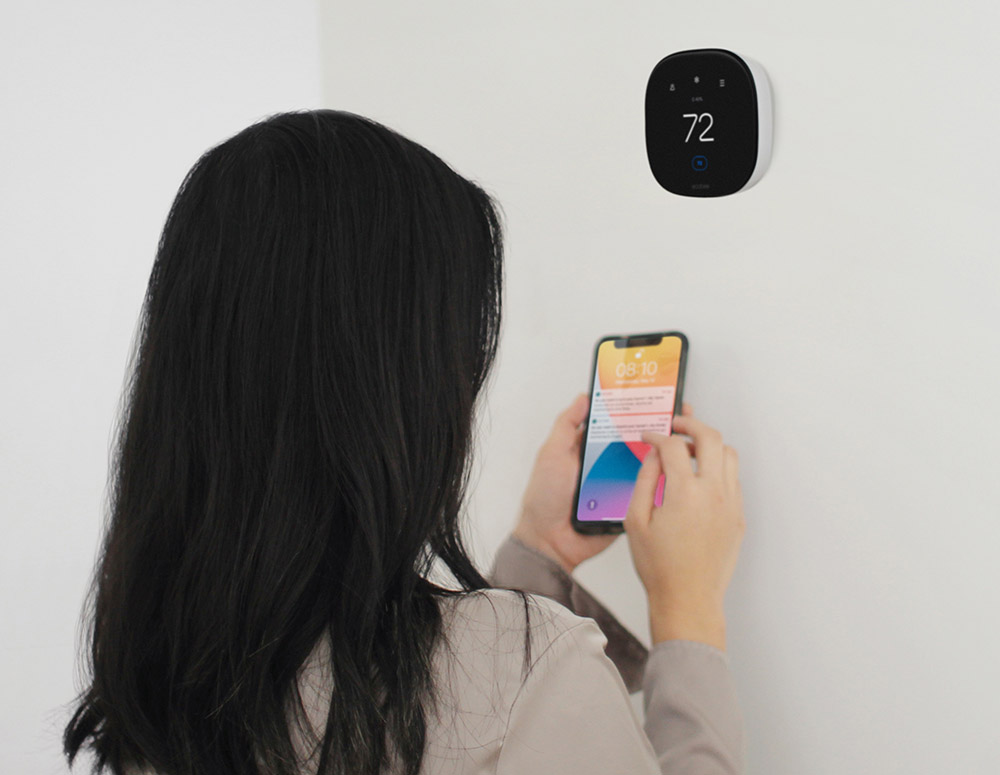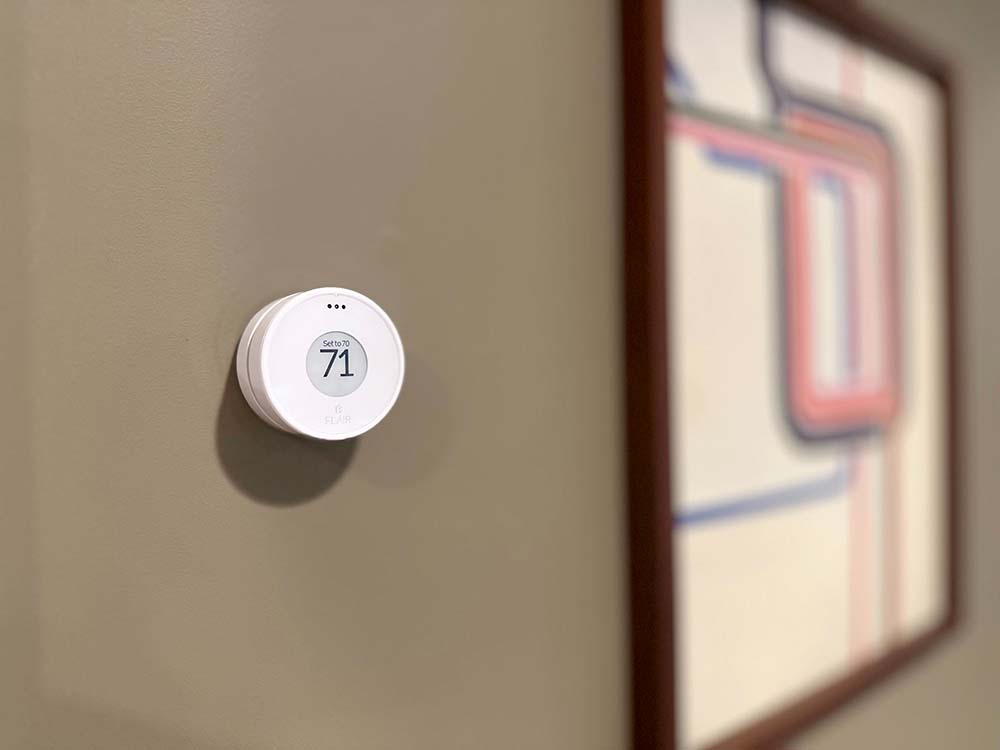Traditional thermostats don’t know it’s broke ‘til it’s broke. Smart thermostats, on the other hand, can detect a potential problem through intelligent preventive maintenance offerings: alerts and notifications that tell the customer and homeowner when it’s time for service, monitoring capabilities that allow the HVAC contractor to diagnose a problem remotely. There are also a number of benefits for the consumer’s bottom line, like geofencing, energy efficiency, and utility rebates. All of these can be great selling points for contractors — as long as techs can explain the ins and outs of utility rebates like demand-response programs.
Preventative Maintenance
Two key ways smart thermostats aid contractors in preventive maintenance are through alerts/reminders, and the connectivity they offer contractors.
“Traditional thermostats are reactive in nature … Connected HVAC solutions can turn that reactive situation into a proactive one,” said Dave Quam, services & solutions director at Resideo.
The ability to check the performance of the smart thermostat remotely offers contractors insight into the very high-level outputs of the system and the home’s performance — such as ensuring that when a certain temperature is set, that temperature is produced — and then the more granular details, like historic home temperature data, or trends and insights. Those kind of diagnostics can be really helpful when trying to understand where the problem is coming from, and even give contractors an opportunity to get ahead of it. Contractors can show up to the site prepared with the necessary tools to fix the problem. Or they might not even need to show up at all after determining the issue.
Andrew Gaichuk, senior director of technical operations at ecobee, said depending on how the system is configured and what accessories are added, there are alert options that allow for intervals to be set up as to when the thermostat owner/contractor will get that notification to maintain or replace components that require regular maintenance, such as the HVAC system, furnace filter, a UV germicidal lamp, humidifier, a dehumidifier, or a ventilator.
To make it easy for the homeowner to contact their contractor if service is needed, some smart thermostats have a “who to call for service” feature, where the HVAC contractor can add their own logo and contact information, said Tony Albers, product manager at Venstar Inc.
In addition to setting up that annual or semiannual HVAC maintenance on the smart thermostat itself, more and more smart thermostats have a paired mobile app where settings can be configured, and homeowners and HVAC contractors can easily view the functions of the smart thermostat.
“If any of many alerts we have available are triggered, the homeowner will get an immediate email from [the mobile app] that will identify the issue. This allows contractors to react quickly if any issues arise,” said Jason Schneider, regional sales manager at Venstar Inc.
Cost Savings
While energy-efficient light bulbs and high-efficiency appliances are essential in the fight for energy and cost savings, smart thermostats can a big impact on a homeowner’s finances.
“According to the U.S. Department of Energy, heating and cooling account for nearly 50% of the energy consumption in a typical U.S. home — on average, costing homeowners about $900 a year — making it the most significant energy expenditure for most households,” Quam said.
Oftentimes when a thermostat isn’t programmed, it will run unnecessarily for hours, wasting both energy and money. Many smart thermostats offer “home” and “away” buttons to helps aid that.
Setting a system for “home” or “away” can also be done through most smart thermostats’ mobile apps, and they even offer a runtime chat to show the homeowner how much their unit has been running, said Schneider. Many smart thermostats today also offer a geofencing feature that sets a perimeter around the home. When the last person (or, more accurately, the last phone) leaves the home, the smart thermostat kicks into energy saving mode.

MOBILE: Customers can link their smart thermostat with an app that provides remote connectivity to both the contractor and the homeowner. (Courtesy of ecobee)
Gaichuk said the ecobee smart thermostat with eco+ Schedule Assistant enabled has the capability through its sensors to determine and provide recommendations based on occupancy patterns, if there’s an opportunity to modify the heating and cooling schedule set by the customer to further enhance savings.
“For example, if your home has a basement (and typically cold air falls to the lower levels of the home) and you're spending the evening in the basement, watching TV, an ecobee smart sensor in the basement will detect occupancy and prioritize the temperatures readings to reflect the overall thermostat temperature and compare that to your set point. As a result, it will engage the heating a little bit more often to provide that comfort where it's needed.”
And since a smart thermostat learns the home's heating and cooling patterns, it can deliver the right temperature at the right time, leading to more energy efficient use.

SET POINT: Smart thermostats provide reliable comfort through programmed set points. (Courtesy of Flair)
Daniel Myers, CEO and co-founder of Flair, pointed out that while smart thermostats can save energy, operating the sensors themselves can also result in more energy being used. It’s a tradeoff; this might be perfectly reasonable in the pursuit of a homeowner’s comfort. Without remote sensors, less energy is used, but multiple rooms in a home are left not reliably comfortable. Depending on the customer, that could be their biggest frustration point.
Rebate and Educate
HVAC contractors have to play a key role in the shift toward energy efficiency. They need to be educated on these energy efficiency solutions to educate the customer, and they also need to know how to sell them. Part of that is knowing what rebates to highlight for customers or what utility programs are offered, and the other is knowing what that means for the homeowner in terms of comfortability and savings and where to direct customers.
There are a variety of rebates, Gaichuk said, and manufacturers often provide updated links for customers based on the utility. Ecobee has a rebate finder (using zip/postal code) and a link to the current utility incentive programs for the various regions.
HVAC contractors can direct customers to the website of their local energy company to see if their smart thermostat qualifies for any energy rebates. Manufacturers have also updated their mobile apps to prompt customers to enroll in a relevant rebate program based on their zip code.
“Oftentimes, the HVAC contractor can help the homeowner with that by letting them know that there is a rebated program for that [smart] thermostat and that they just need to go to this website or resource to find it. It’s just a really nice thing to do for them,” Myers said.
During extreme weather events when systems are cranked one way or the other, the electric grid is strained, which can result in service interruptions. So, many utilities have offered demand-response programs, which sometimes offer incentives to customers if they opt into the program.
“In the past, these programs were one-way communication, such as paging. The technology used today offers two-way communication, so that homeowners are aware when an energy saving program is active,” Quam said.
Demand-response events ultimately mean the utility company is calling the shots during that time period. This is something an HVAC contractor needs to tell a customer upfront because when the furnace or a/c isn’t heating or cooling, it’s often the contractor who ends up on the other side of an angry call from the homeowner whose equipment isn’t responding to the thermostat.
“If this is the case, then the best bet is to first check the thermostat to see if an event is currently enabled. From there, they can call their utility company and confirm if they are currently engaging in any sort of set point modifications, and if so, for how long,” Albers said.
Myers stressed an HVAC contractor’s role when it comes to utility programs.
“An HVAC contractor is going to want to tell their customers that they are going to try to get recruited into this program. And particularly if the program doesn’t have an opt-out feature, they should really think long and hard about it.”
There’s also a lot of variety in the rebate programs that do a good job of training contractors in getting the word out and making sure those rebates are available to honestly help contractors win more jobs.
“The contractors who consistently have the highest satisfaction, get the most referrals, are the ones engaged in those programs … It might not be fun. You might want to be playing with the vacuum pump and wiring things, but at the end of the day, that’s a lot of money to leave on the table,” Myers said.



Report Abusive Comment